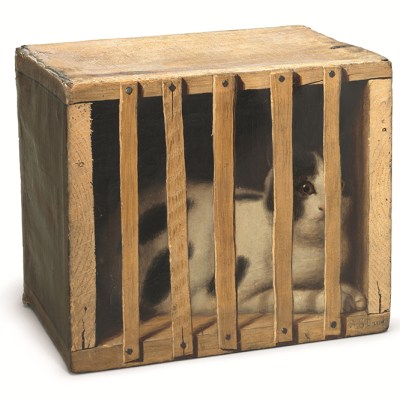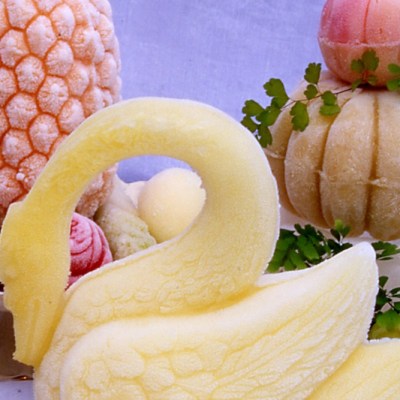The trompe l’œil has an image problem. The genre – in its narrowest sense a group of works that create an optical illusion, typically tricking the viewer into mistaking the representation of an object for the object itself – has long been relegated to the ranks of ‘low art’. Its beguiling feats of deception and preoccupation with everyday artefacts mean that it has often been considered too vulgar, too popular, too whimsical, to be taken seriously. In 19th-century France, where the term was first coined, it was seen as being on a par with circuses and street performers: a crowd-pleasing stunt that brought the burgeoning middle classes flocking. It has never quite managed to shrug off this reputation.
This exhibition at the Musée Marmottan Monet in Paris is a chance to assess the merits of the genre as well as to reconsider the scope of what a trompe l’œil might be. The show offers a chronological survey, beginning with the genre’s golden age in the 17th-century Netherlands. Artists such as Cornelis Norbertus Gijsbrechts ushered in a highly codified tradition: paintings that tend to stick to the same small set of subjects – letters, documents, etchings, ribbons, quills and eyeglasses – rendered in virtuosic detail.
Trompe-l’oeil with painting implements and engravings (before 1715), Cristoforo Munari. Collection of Farida et Henri Seydoux, Paris. Photo: © Studio Christian Baraja SLB

What is striking in these early examples is how quickly they make painting the subject of painting. Many of the works depict the paraphernalia of artistic practice: palettes, brushes, frames within frames. The maulstick that exceeds the edge of the canvas in Cristoforo Munari’s Trompe-l’œil with painting implements and engravings (before 1715), foregrounds the material supports usually hidden from view, highlighting the process – and by extension, the artifice – of making art. (Although not in the exhibition, this 17th-century meta-pictural bent is best exemplified by Gijsbrechts’ Reverse of a Framed Painting (1670) in the SMK in Copenhagen – a work that feels remarkably modern.)
As the exhibition progresses through examples from the 18th and early 19th centuries, we see the assorted tricks artists conjured to sneak self-portraits and personal jokes into otherwise rote works commissioned by wealthy patrons. Louis-Léopold Boilly’s Trompe-l’œil with coins, on the surface of a gueridon (c. 1808–15), believed to have been painted for Napoleon, contains both a miniature of the artist and a torn strip of paper bearing the address of his studio, magnified under a looking glass. Not only was this an astute publicity stunt – Boilly complemented his commissions for high-profile clients with a side business selling cheap miniatures – but it also represents an assertion of self, both playful and serious, within the confines of a compartmentalised genre.
Trompe-l’œil with coins, on the surface of a gueridon (c. 1808–15), Louis-Léopold Boilly. Photo: © Stephane Marechalle/Lille, Palais des Beaux-Arts/RmnGrandPalais
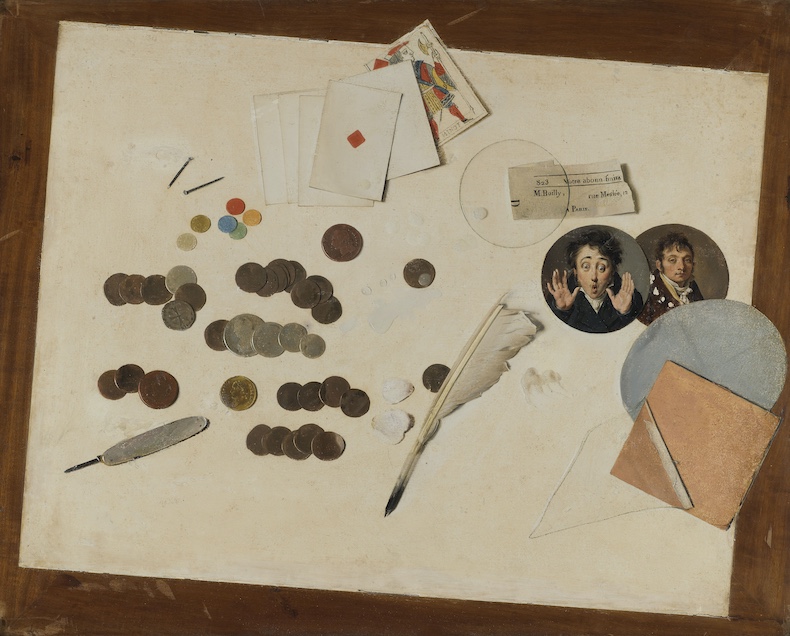
The exhibition moves on, via a not especially inspiring collection of paintings which represent the revival of the trompe l’œil in the United States in the 19th century, to the modern period. Here, the genre broadens out. Some works return to the preoccupation with the everyday, such as Daniel Spoerri’s Tisch N° 5 (1968), which consists of a tabletop bearing the remnants of a meal, hung up vertically on the wall. Combining glued-on wine glasses with cigarette butts that, on closer inspection, turn out to be ceramic, it is, in a sense, trompe l’œil in its purest form: the real that reveals itself to be an imitation.
On the wall opposite is an unlikely but inspired inclusion: Michelangelo Pistoletto’s Deposizione (1973). One of the artist’s mirror paintings, it features human figures in the foreground set on a backdrop of polished stainless steel. With its reflective surface, the work extends to its logical conclusion a long-standing concern of trompe l’oeil: the participation of the viewer in the artwork. The genre is, more than most, dependent on the eye of the viewer to bring it to life; Pistoletto goes further by producing a work which cannot be seen without the onlooker (or more precisely, their image) becoming an integral part. In a clever feat of curation, it reflects Spoerri’s tabletop on the wall opposite, presenting a mise en abyme – an illusion of something real that is in turn an illusion of something real, raising the troubling question of where reality ends and its image begins.
Spatial transcendence (1960), Henri Cadiou. © ADAGP, Paris 2024
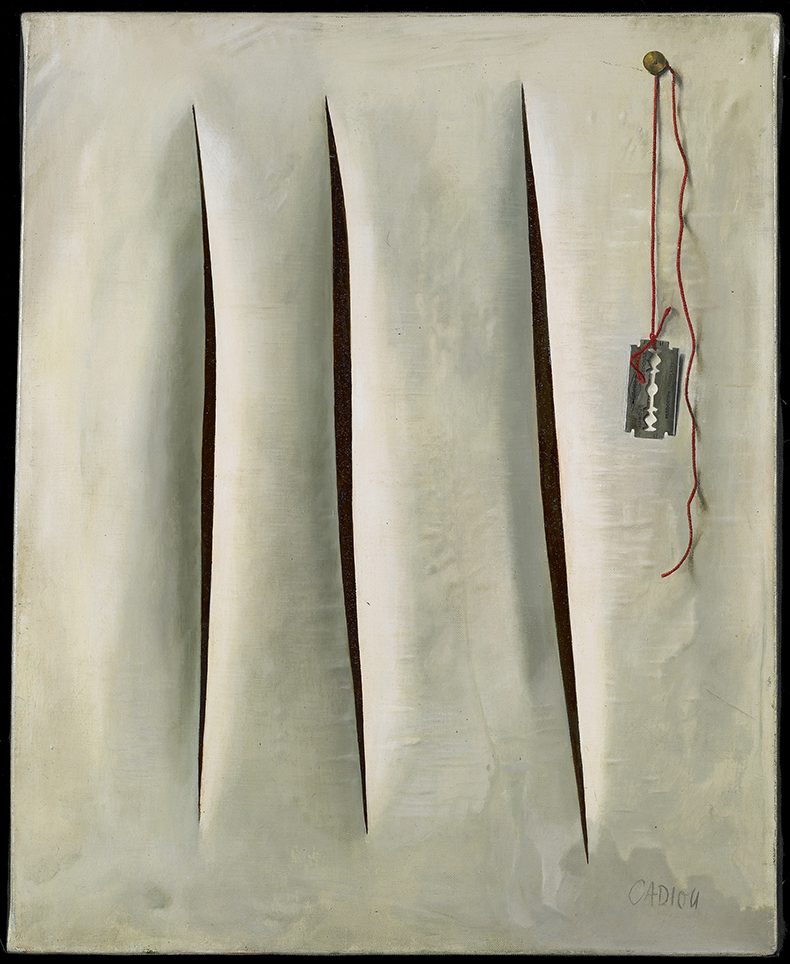
While Pistoletto’s painting reflects another artwork in a literal sense, other pictures in the exhibition do so through allusion. A striking example of this is Henri Cadiou’s Spatial transcendence (1960), an oil painting that depicts a work resembling one of Lucio Fontana’s slashed canvases, with the addition of a razor blade hanging from a red thread. The air of menace is anything but accidental. Cadiou saw Fontana’s work as representative of an abstract movement that considered figurative painting redundant and thus posed a threat to its very existence. The gesture of representing radical abstraction via one of art’s oldest mimetic traditions is a powerful one: an attempt to tame, perhaps, and a defiant rebuttal.
Cadiou’s painting continues the tradition of earlier trompe l’œil but takes it a step further: this is not just painting about painting, but a painting about painting as it relates to other art forms, and a critical meditation on the state of figurative art. Far from a fleeting optical illusion, Spatial transcendence, like many other works in the exhibition, suggest that the trompe-l’œil can have a lot more to say.
Trompe l’oeil with a ribbon in front of a landscape of the Portuguese countryside (c. 1790), Jean Pillement. Collection of Farida and Henri Seydoux, Paris. Photo: © Studio Christian Baraja SLB
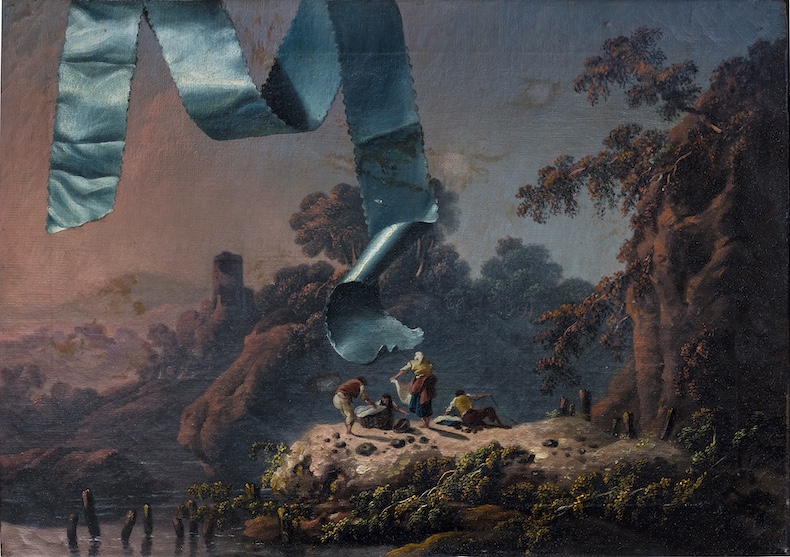
‘Trompe-l’œil, from 1520 to the present day’ is at the Musée Marmottan Monet until 2 March 2025.

